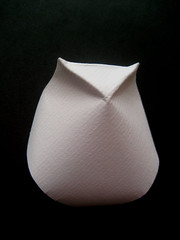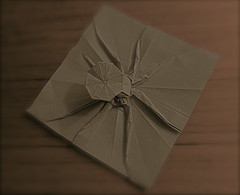This piece is the latest in a series of minimalist owls by Tuan Nguyen Tu, who for the past six months has been exploring simple, symbolic origami. This is an excellent example of how little technique is required to bring across a subject; many designers would have six or seven points, but he's shown us that we don't need any points at all, if we know how to make the paper work in our favor.
I admit this is sort of a theme for me, but I am reminded again not to think in terms of points, but in terms of lines-- visual artistry instead of pure structure.
I've been working on adding faces to boxpleated models, so the subject was already in my mind. Nonetheless, sculptures like this owl remind me how far I have yet to go still...
Saturday, February 28, 2009
Tuesday, October 21, 2008
Knowing when to make a point
I've sadly let this blog fall into disuse, but I've been doing some thinking that I find significant, but my Flickr page really isn't the right place to go on and on like I can here.
So here goes: there's something that's been bothering me about representational folding. Yes, we have technical complexity, and with it paperfolders have done some truly amazing things. Some prominent origamists have, however, noted that many creators tend to pursue complexity without regard to artistic expression, sometimes even forsaking aesthetic pleasure to add more detail. This has become a widely accepted opinion, but I think it neglects a more important issue: in the pursuit of more detail, are we forgetting the principles of good design as well?
I think there's a balance to design philosophy that is often ignored; yes, we must know when, how, and where to put in another point or two for detail... but we also need to keep in mind when NOT to put in another point. This spider is an example of what I'm talking about; there are all these ways to avoid putting in more points than are necessary, and these often lead to cleverer, more elegant models that we would otherwise end up with. I could have created a spider with eight legs and an abdomen, a total of nine points; but instead I created this one, which only uses one. It's much a much more efficient paper distribution, and can therefore be folded with a paper that will give it weight, without sacrificing the thinness of the legs.
At this point, with boxpleating and circle-packing techniques, it's really not that hard to create a complex model. What's still hard is to create a clever model, whether complex or not; and this provides a creative challenge that I think a lot of today's creators need.
We need to stop thinking in terms of numbers of points, and evaluate models based on their aesthetic and intellectual value.
So here goes: there's something that's been bothering me about representational folding. Yes, we have technical complexity, and with it paperfolders have done some truly amazing things. Some prominent origamists have, however, noted that many creators tend to pursue complexity without regard to artistic expression, sometimes even forsaking aesthetic pleasure to add more detail. This has become a widely accepted opinion, but I think it neglects a more important issue: in the pursuit of more detail, are we forgetting the principles of good design as well?
I think there's a balance to design philosophy that is often ignored; yes, we must know when, how, and where to put in another point or two for detail... but we also need to keep in mind when NOT to put in another point. This spider is an example of what I'm talking about; there are all these ways to avoid putting in more points than are necessary, and these often lead to cleverer, more elegant models that we would otherwise end up with. I could have created a spider with eight legs and an abdomen, a total of nine points; but instead I created this one, which only uses one. It's much a much more efficient paper distribution, and can therefore be folded with a paper that will give it weight, without sacrificing the thinness of the legs.
At this point, with boxpleating and circle-packing techniques, it's really not that hard to create a complex model. What's still hard is to create a clever model, whether complex or not; and this provides a creative challenge that I think a lot of today's creators need.
We need to stop thinking in terms of numbers of points, and evaluate models based on their aesthetic and intellectual value.
Sunday, February 10, 2008
Atlas and the Minotaur
These are actually based on the same packing, but the minotaur is a half sheet. The rest of the sheet went to make the world on Atlas' shoulders. To do this, I spread the pleats using some curved folds. Those pleats are then locked at the top end with a simple mountain fold on each one. They continue up through the shoulder to become the arms and head, which in turn become the fingers and legs.
Aside from the obvious technical challenge, I was trying to work on ways to put faces on these models. It's something I've been grappling with ever since my faceless Valkyrie, and I think these two worked for the corresponding level of complexity of the body. I'll keep working on that, though.
I'd like to give a tip of the hat to Oschene for providing the inspiration on how to make a sphere. I realize I should have done that when I folded the Klein Bottle, but I suppose it's better late than never.
About an hour after I made Atlas, I was sitting in my history class, listening to a lecture about capitalism. Somebody next to me (evidently as bored as I was) asked me what I had folded. After a second or two of reflection, I hypothesized that this, then, was the atlas that didn't shrug. I received nothing but a blank stare. No accounting for taste, I suppose...
www.flickr.com/photos/ahudson
Aside from the obvious technical challenge, I was trying to work on ways to put faces on these models. It's something I've been grappling with ever since my faceless Valkyrie, and I think these two worked for the corresponding level of complexity of the body. I'll keep working on that, though.
I'd like to give a tip of the hat to Oschene for providing the inspiration on how to make a sphere. I realize I should have done that when I folded the Klein Bottle, but I suppose it's better late than never.
About an hour after I made Atlas, I was sitting in my history class, listening to a lecture about capitalism. Somebody next to me (evidently as bored as I was) asked me what I had folded. After a second or two of reflection, I hypothesized that this, then, was the atlas that didn't shrug. I received nothing but a blank stare. No accounting for taste, I suppose...
www.flickr.com/photos/ahudson
Wednesday, January 9, 2008
Origami in China
As many of you know (especially the o-list folks) I took a two-week trip to China with family and freinds during the latter half of December. I promised that any origami I saw would be captured, tagged, and released back into the wild, as it were... so here they are.
I observed these folded objects in a pagoda and a restaurant, respectively. I was unable to procure instructions, as nobody was around in either case; the one on the left seems to be made from a long strip of cloth, crimped into a spiral then gathered at the back. I saw several things like it, so there may be some sort of diagram out threse somewhere.
The yellow object on the left (which has, surely, seen better days!) was part of a Buddhist shrine, so I didn't get the chance to examine it very closely... but here's a picture, anyway. It's from the Wild Goose Pagoda in the city of Xi'an, if any of you want to look it up... you have to climb the pagoda, though. It's on the third or fourth level if I remember right. I assume it's multi-piece, and in fact it looks like it may well be a variation on the modular lotus presented in David Mitchell's "Chinese Origami".
Sadly, aside from these two fabulous examples, I didn't see anything other than the ubiquitous napkin-folding, and only one of those was something I hadn't seen before... but I don't eat out much, so that doesn't mean anything. I reverse-engineered it in about three minutes, so I should be able to fold another one and take pictures if anybody's interested.
On a different note, I realized that this is my 100th photo post on flickr... But I'm a cheapskate and don't want to buy a Pro account, so I am tenatively announcing that I am in the process of designing/obtaining a website for my origami, and hope to have at least an image archive up by the end of the month, and maybe a full-fledged website by March or April (that would be new year's resolution number one).
So, Happy New Year everybody! And may it be a good one. Catch you all later.
I observed these folded objects in a pagoda and a restaurant, respectively. I was unable to procure instructions, as nobody was around in either case; the one on the left seems to be made from a long strip of cloth, crimped into a spiral then gathered at the back. I saw several things like it, so there may be some sort of diagram out threse somewhere.
The yellow object on the left (which has, surely, seen better days!) was part of a Buddhist shrine, so I didn't get the chance to examine it very closely... but here's a picture, anyway. It's from the Wild Goose Pagoda in the city of Xi'an, if any of you want to look it up... you have to climb the pagoda, though. It's on the third or fourth level if I remember right. I assume it's multi-piece, and in fact it looks like it may well be a variation on the modular lotus presented in David Mitchell's "Chinese Origami".
Sadly, aside from these two fabulous examples, I didn't see anything other than the ubiquitous napkin-folding, and only one of those was something I hadn't seen before... but I don't eat out much, so that doesn't mean anything. I reverse-engineered it in about three minutes, so I should be able to fold another one and take pictures if anybody's interested.
On a different note, I realized that this is my 100th photo post on flickr... But I'm a cheapskate and don't want to buy a Pro account, so I am tenatively announcing that I am in the process of designing/obtaining a website for my origami, and hope to have at least an image archive up by the end of the month, and maybe a full-fledged website by March or April (that would be new year's resolution number one).
So, Happy New Year everybody! And may it be a good one. Catch you all later.
Subscribe to:
Posts (Atom)



